airbag off CHEVROLET SILVERADO 2011 2.G Owners Manual
[x] Cancel search | Manufacturer: CHEVROLET, Model Year: 2011, Model line: SILVERADO, Model: CHEVROLET SILVERADO 2011 2.GPages: 588, PDF Size: 7.99 MB
Page 10 of 588

Black plate (4,1)Chevrolet Silverado Owner Manual - 2011
1-4 In Brief
V.Power Outlets on page 5‑10.
W. Climate Control Systems (with
Air Conditioning)
on page 8‑1orClimate Control Systems
(with Heater Only)on
page 8‑4(If Equipped).
Dual Automatic Climate
Control System
on page 8‑5(If Equipped).
X. Power Take Off (PTO) Control (If Equipped). See Power Take
Off (PTO) in the Duramax diesel
supplement Index.
Y. Passenger Airbag Off Control (If Equipped). See Airbag
On-Off Switch on page 3‑39.
Z. Glove Box on page 4‑1.
Page 13 of 588

Black plate (7,1)Chevrolet Silverado Owner Manual - 2011
In Brief 1-7
A.Air Vents on page 8‑11.
B. Turn and Lane-Change Signals
on page 6‑6.
Windshield Wiper/Washer
on
page 5‑5.
C. Instrument Cluster
on
page 5‑13.
D. Hazard Warning Flashers
on
page 6‑5.
E. Shift Lever. See Automatic
Transmission on page 9‑43.
F. Tow/Haul Mode
on page 9‑49(If Equipped).
G. Driver Information Center (DIC) Buttons. See Driver Information
Center (DIC) on page 5‑34.
H. AM-FM Radio on page 7‑8.
I. Exterior Lamp Controls
on
page 6‑1.
J. Integrated Trailer Brake Controller (If Equipped).
See Trailer Towing
on
page 9‑94. K.
Dome Lamps
on page 6‑8.
L. Automatic Transfer Case Control. (If Equipped).
See Four-Wheel Drive
on
page 10‑32.
M. Data Link Connector (DLC). See Malfunction Indicator Lamp
on page 5‑27.
N. Hood on page 10‑5.
O. Parking Brake on page 9‑68.
P. Cruise Control on page 9‑73.
Q. Steering Wheel Adjustment
on
page 5‑2.
R. Horn on page 5‑5.
S. Steering Wheel Controls
on
page 5‑3.
T. Climate Control Systems (with
Air Conditioning)
on page 8‑1orClimate Control Systems
(with Heater Only)on
page 8‑4(If equipped).
Dual Automatic Climate
Control System
on page 8‑5(If Equipped). U.
Power Outlets on page 5‑10.
Cigarette Lighter (If Equipped).
See Ashtrays
on page 5‑12andCigarette Lighteron
page 5‑11.
V. StabiliTrak
®Systemon
page 9‑70(If Equipped).
Pedal Adjust Button
(If Equipped). See Adjustable
Throttle and Brake Pedal
on
page 9‑32.
Ultrasonic Parking Assist
on
page 9‑76(If Equipped).
Exhaust Brake (If Equipped).
See "Brakes" in the Duramax
Diesel Supplement.
W. Passenger Airbag Off Control (If Equipped). See Airbag
On-Off Switch on page 3‑39.
X. Glove Box on page 4‑1.
Page 21 of 588
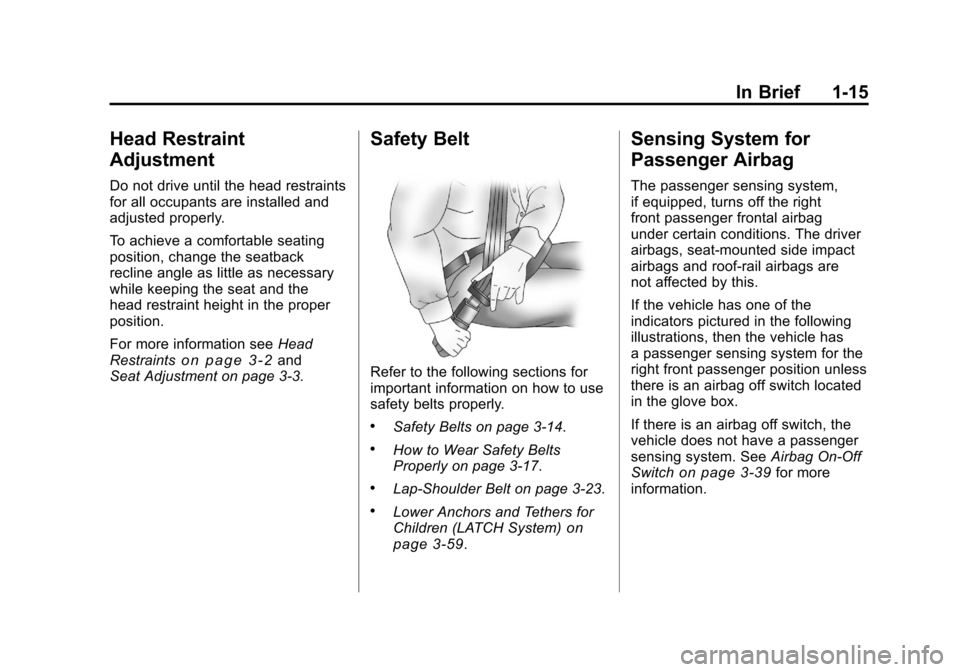
Black plate (15,1)Chevrolet Silverado Owner Manual - 2011
In Brief 1-15
Head Restraint
Adjustment
Do not drive until the head restraints
for all occupants are installed and
adjusted properly.
To achieve a comfortable seating
position, change the seatback
recline angle as little as necessary
while keeping the seat and the
head restraint height in the proper
position.
For more information seeHead
Restraints
on page 3‑2and
Seat Adjustment on page 3‑3.
Safety Belt
Refer to the following sections for
important information on how to use
safety belts properly.
.Safety Belts on page 3‑14.
.How to Wear Safety Belts
Properly on page 3‑17.
.Lap-Shoulder Belt on page 3‑23.
.Lower Anchors and Tethers for
Children (LATCH System)on
page 3‑59.
Sensing System for
Passenger Airbag
The passenger sensing system,
if equipped, turns off the right
front passenger frontal airbag
under certain conditions. The driver
airbags, seat‐mounted side impact
airbags and roof‐rail airbags are
not affected by this.
If the vehicle has one of the
indicators pictured in the following
illustrations, then the vehicle has
a passenger sensing system for the
right front passenger position unless
there is an airbag off switch located
in the glove box.
If there is an airbag off switch, the
vehicle does not have a passenger
sensing system. See Airbag On-Off
Switch
on page 3‑39for more
information.
Page 69 of 588
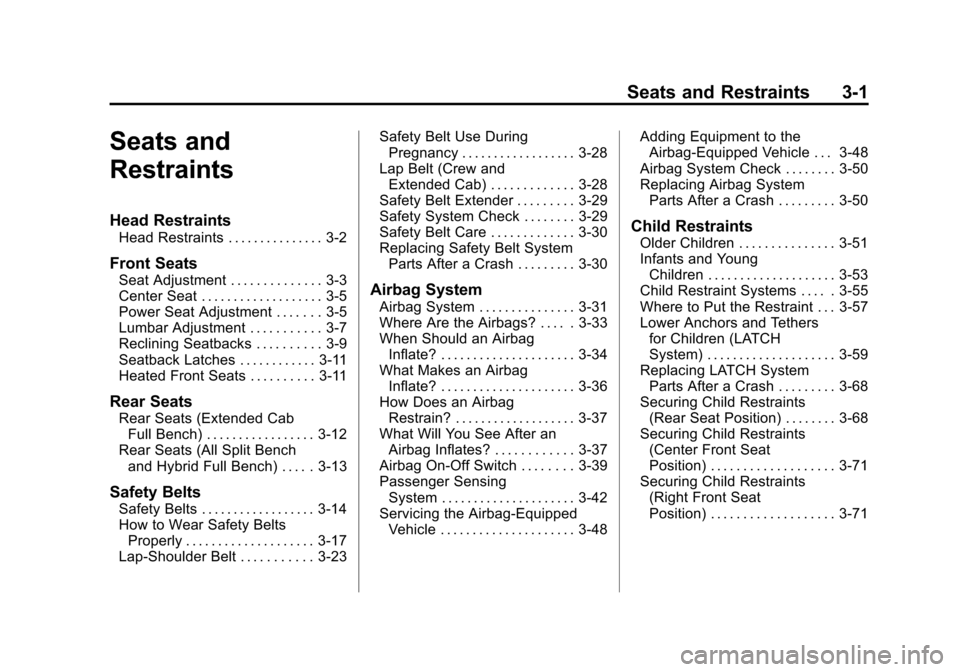
Black plate (1,1)Chevrolet Silverado Owner Manual - 2011
Seats and Restraints 3-1
Seats and
Restraints
Head Restraints
Head Restraints . . . . . . . . . . . . . . . 3-2
Front Seats
Seat Adjustment . . . . . . . . . . . . . . 3-3
Center Seat . . . . . . . . . . . . . . . . . . . 3-5
Power Seat Adjustment . . . . . . . 3-5
Lumbar Adjustment . . . . . . . . . . . 3-7
Reclining Seatbacks . . . . . . . . . . 3-9
Seatback Latches . . . . . . . . . . . . 3-11
Heated Front Seats . . . . . . . . . . 3-11
Rear Seats
Rear Seats (Extended CabFull Bench) . . . . . . . . . . . . . . . . . 3-12
Rear Seats (All Split Bench and Hybrid Full Bench) . . . . . 3-13
Safety Belts
Safety Belts . . . . . . . . . . . . . . . . . . 3-14
How to Wear Safety BeltsProperly . . . . . . . . . . . . . . . . . . . . 3-17
Lap-Shoulder Belt . . . . . . . . . . . 3-23 Safety Belt Use During
Pregnancy . . . . . . . . . . . . . . . . . . 3-28
Lap Belt (Crew and Extended Cab) . . . . . . . . . . . . . 3-28
Safety Belt Extender . . . . . . . . . 3-29
Safety System Check . . . . . . . . 3-29
Safety Belt Care . . . . . . . . . . . . . 3-30
Replacing Safety Belt System
Parts After a Crash . . . . . . . . . 3-30
Airbag System
Airbag System . . . . . . . . . . . . . . . 3-31
Where Are the Airbags? . . . . . 3-33
When Should an AirbagInflate? . . . . . . . . . . . . . . . . . . . . . 3-34
What Makes an Airbag Inflate? . . . . . . . . . . . . . . . . . . . . . 3-36
How Does an Airbag Restrain? . . . . . . . . . . . . . . . . . . . 3-37
What Will You See After an Airbag Inflates? . . . . . . . . . . . . 3-37
Airbag On-Off Switch . . . . . . . . 3-39
Passenger Sensing System . . . . . . . . . . . . . . . . . . . . . 3-42
Servicing the Airbag-Equipped Vehicle . . . . . . . . . . . . . . . . . . . . . 3-48 Adding Equipment to the
Airbag-Equipped Vehicle . . . 3-48
Airbag System Check . . . . . . . . 3-50
Replacing Airbag System Parts After a Crash . . . . . . . . . 3-50
Child Restraints
Older Children . . . . . . . . . . . . . . . 3-51
Infants and Young
Children . . . . . . . . . . . . . . . . . . . . 3-53
Child Restraint Systems . . . . . 3-55
Where to Put the Restraint . . . 3-57
Lower Anchors and Tethers for Children (LATCH
System) . . . . . . . . . . . . . . . . . . . . 3-59
Replacing LATCH System Parts After a Crash . . . . . . . . . 3-68
Securing Child Restraints (Rear Seat Position) . . . . . . . . 3-68
Securing Child Restraints (Center Front Seat
Position) . . . . . . . . . . . . . . . . . . . 3-71
Securing Child Restraints (Right Front Seat
Position) . . . . . . . . . . . . . . . . . . . 3-71
Page 100 of 588
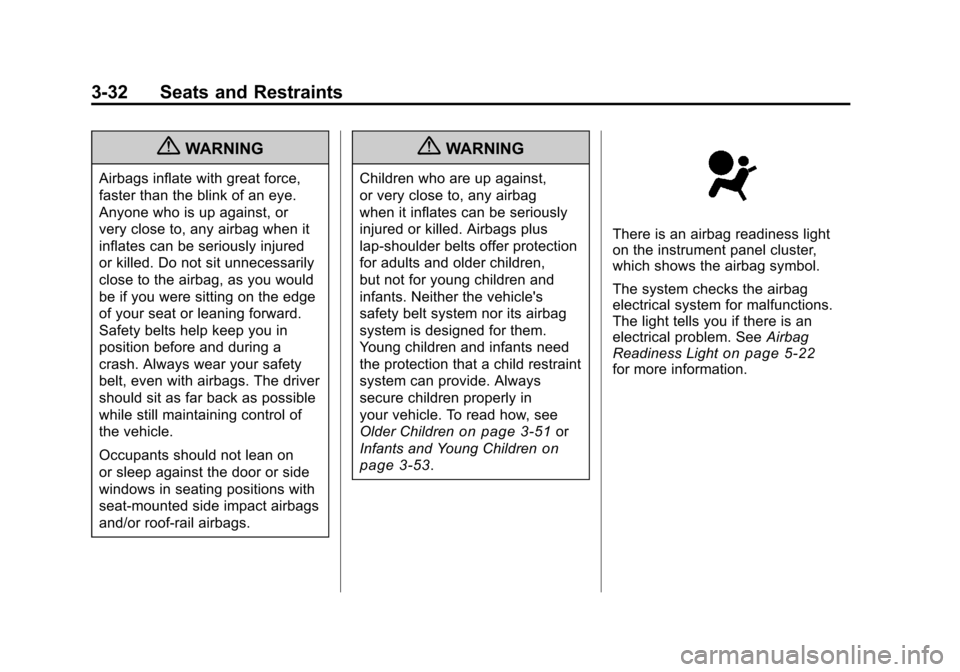
Black plate (32,1)Chevrolet Silverado Owner Manual - 2011
3-32 Seats and Restraints
{WARNING
Airbags inflate with great force,
faster than the blink of an eye.
Anyone who is up against, or
very close to, any airbag when it
inflates can be seriously injured
or killed. Do not sit unnecessarily
close to the airbag, as you would
be if you were sitting on the edge
of your seat or leaning forward.
Safety belts help keep you in
position before and during a
crash. Always wear your safety
belt, even with airbags. The driver
should sit as far back as possible
while still maintaining control of
the vehicle.
Occupants should not lean on
or sleep against the door or side
windows in seating positions with
seat-mounted side impact airbags
and/or roof-rail airbags.
{WARNING
Children who are up against,
or very close to, any airbag
when it inflates can be seriously
injured or killed. Airbags plus
lap-shoulder belts offer protection
for adults and older children,
but not for young children and
infants. Neither the vehicle's
safety belt system nor its airbag
system is designed for them.
Young children and infants need
the protection that a child restraint
system can provide. Always
secure children properly in
your vehicle. To read how, see
Older Children
on page 3‑51or
Infants and Young Children
on
page 3‑53
.
There is an airbag readiness light
on the instrument panel cluster,
which shows the airbag symbol.
The system checks the airbag
electrical system for malfunctions.
The light tells you if there is an
electrical problem. See Airbag
Readiness Light
on page 5‑22for more information.
Page 106 of 588
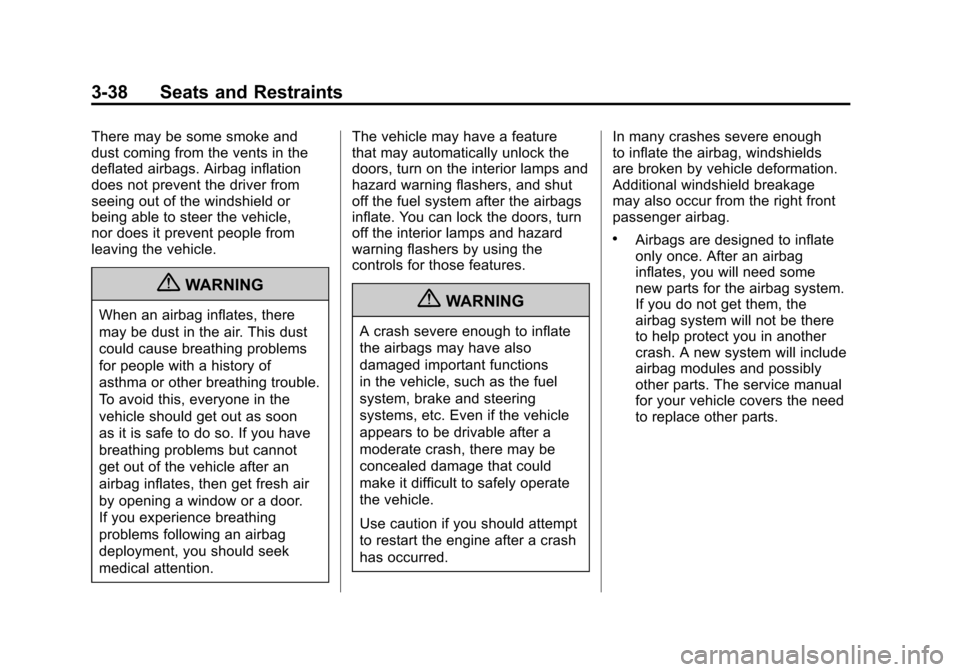
Black plate (38,1)Chevrolet Silverado Owner Manual - 2011
3-38 Seats and Restraints
There may be some smoke and
dust coming from the vents in the
deflated airbags. Airbag inflation
does not prevent the driver from
seeing out of the windshield or
being able to steer the vehicle,
nor does it prevent people from
leaving the vehicle.
{WARNING
When an airbag inflates, there
may be dust in the air. This dust
could cause breathing problems
for people with a history of
asthma or other breathing trouble.
To avoid this, everyone in the
vehicle should get out as soon
as it is safe to do so. If you have
breathing problems but cannot
get out of the vehicle after an
airbag inflates, then get fresh air
by opening a window or a door.
If you experience breathing
problems following an airbag
deployment, you should seek
medical attention.The vehicle may have a feature
that may automatically unlock the
doors, turn on the interior lamps and
hazard warning flashers, and shut
off the fuel system after the airbags
inflate. You can lock the doors, turn
off the interior lamps and hazard
warning flashers by using the
controls for those features.{WARNING
A crash severe enough to inflate
the airbags may have also
damaged important functions
in the vehicle, such as the fuel
system, brake and steering
systems, etc. Even if the vehicle
appears to be drivable after a
moderate crash, there may be
concealed damage that could
make it difficult to safely operate
the vehicle.
Use caution if you should attempt
to restart the engine after a crash
has occurred.
In many crashes severe enough
to inflate the airbag, windshields
are broken by vehicle deformation.
Additional windshield breakage
may also occur from the right front
passenger airbag.
.Airbags are designed to inflate
only once. After an airbag
inflates, you will need some
new parts for the airbag system.
If you do not get them, the
airbag system will not be there
to help protect you in another
crash. A new system will include
airbag modules and possibly
other parts. The service manual
for your vehicle covers the need
to replace other parts.
Page 107 of 588
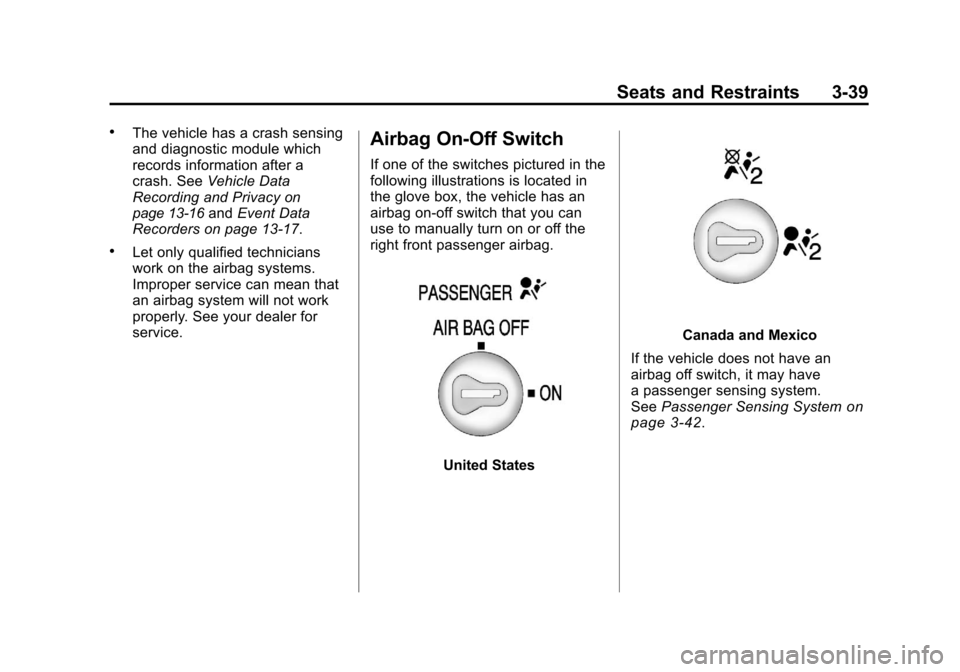
Black plate (39,1)Chevrolet Silverado Owner Manual - 2011
Seats and Restraints 3-39
.The vehicle has a crash sensing
and diagnostic module which
records information after a
crash. SeeVehicle Data
Recording and Privacy
on
page 13‑16and Event Data
Recorders on page 13‑17.
.Let only qualified technicians
work on the airbag systems.
Improper service can mean that
an airbag system will not work
properly. See your dealer for
service.
Airbag On-Off Switch
If one of the switches pictured in the
following illustrations is located in
the glove box, the vehicle has an
airbag on-off switch that you can
use to manually turn on or off the
right front passenger airbag.
United States
Canada and Mexico
If the vehicle does not have an
airbag off switch, it may have
a passenger sensing system.
See Passenger Sensing System
on
page 3‑42.
Page 108 of 588
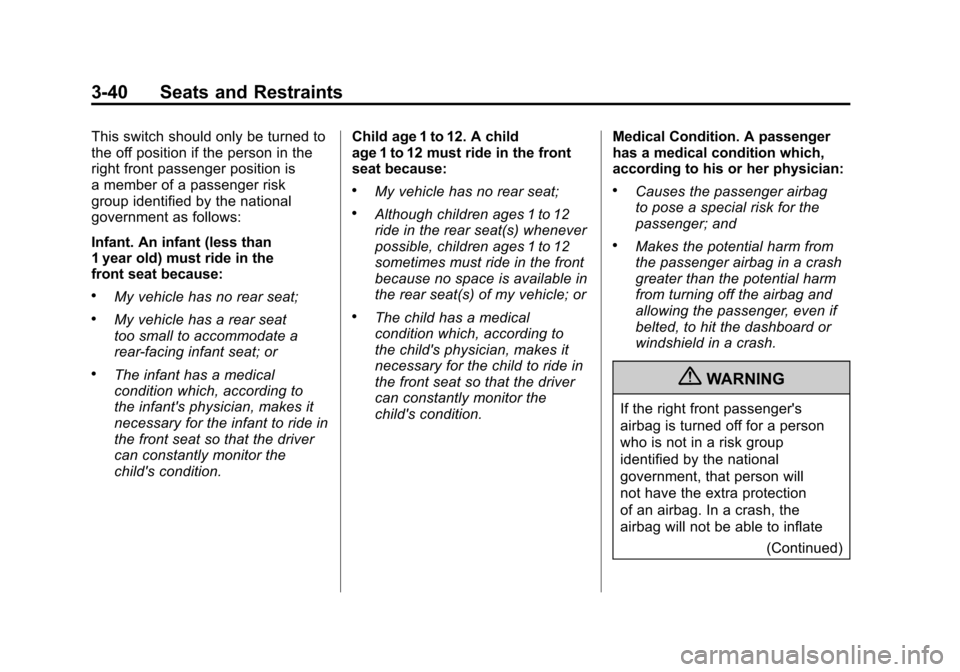
Black plate (40,1)Chevrolet Silverado Owner Manual - 2011
3-40 Seats and Restraints
This switch should only be turned to
the off position if the person in the
right front passenger position is
a member of a passenger risk
group identified by the national
government as follows:
Infant. An infant (less than
1 year old) must ride in the
front seat because:
.My vehicle has no rear seat;
.My vehicle has a rear seat
too small to accommodate a
rear-facing infant seat; or
.The infant has a medical
condition which, according to
the infant's physician, makes it
necessary for the infant to ride in
the front seat so that the driver
can constantly monitor the
child's condition.Child age 1 to 12. A child
age 1 to 12 must ride in the front
seat because:
.My vehicle has no rear seat;
.Although children ages 1 to 12
ride in the rear seat(s) whenever
possible, children ages 1 to 12
sometimes must ride in the front
because no space is available in
the rear seat(s) of my vehicle; or
.The child has a medical
condition which, according to
the child's physician, makes it
necessary for the child to ride in
the front seat so that the driver
can constantly monitor the
child's condition.
Medical Condition. A passenger
has a medical condition which,
according to his or her physician:
.Causes the passenger airbag
to pose a special risk for the
passenger; and
.Makes the potential harm from
the passenger airbag in a crash
greater than the potential harm
from turning off the airbag and
allowing the passenger, even if
belted, to hit the dashboard or
windshield in a crash.
{WARNING
If the right front passenger's
airbag is turned off for a person
who is not in a risk group
identified by the national
government, that person will
not have the extra protection
of an airbag. In a crash, the
airbag will not be able to inflate
(Continued)
Page 109 of 588
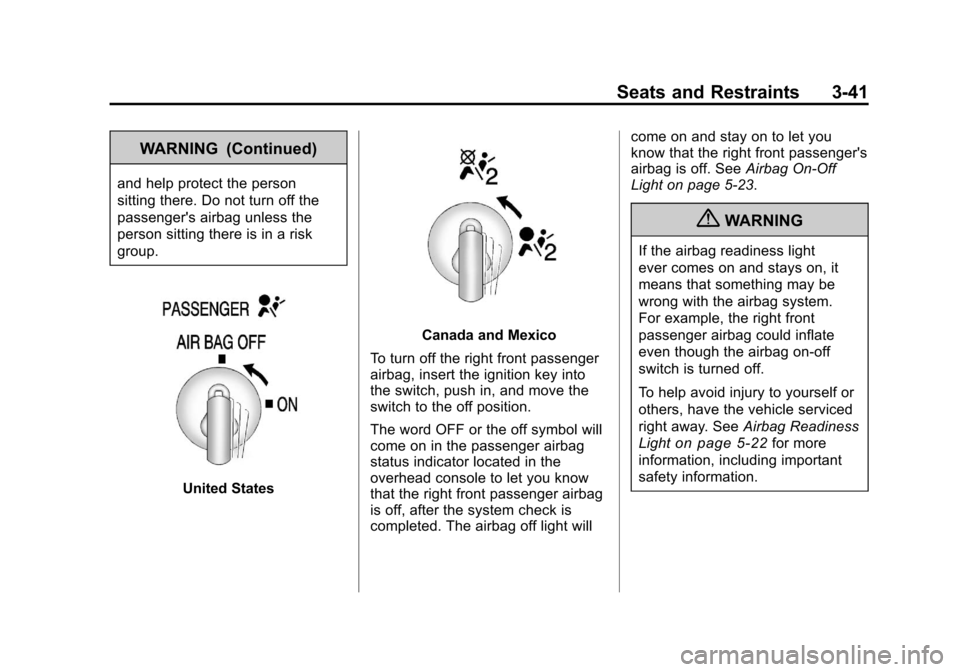
Black plate (41,1)Chevrolet Silverado Owner Manual - 2011
Seats and Restraints 3-41
WARNING (Continued)
and help protect the person
sitting there. Do not turn off the
passenger's airbag unless the
person sitting there is in a risk
group.
United States
Canada and Mexico
To turn off the right front passenger
airbag, insert the ignition key into
the switch, push in, and move the
switch to the off position.
The word OFF or the off symbol will
come on in the passenger airbag
status indicator located in the
overhead console to let you know
that the right front passenger airbag
is off, after the system check is
completed. The airbag off light will come on and stay on to let you
know that the right front passenger's
airbag is off. See
Airbag On-Off
Light on page 5‑23.
{WARNING
If the airbag readiness light
ever comes on and stays on, it
means that something may be
wrong with the airbag system.
For example, the right front
passenger airbag could inflate
even though the airbag on-off
switch is turned off.
To help avoid injury to yourself or
others, have the vehicle serviced
right away. See Airbag Readiness
Light
on page 5‑22for more
information, including important
safety information.
Page 110 of 588
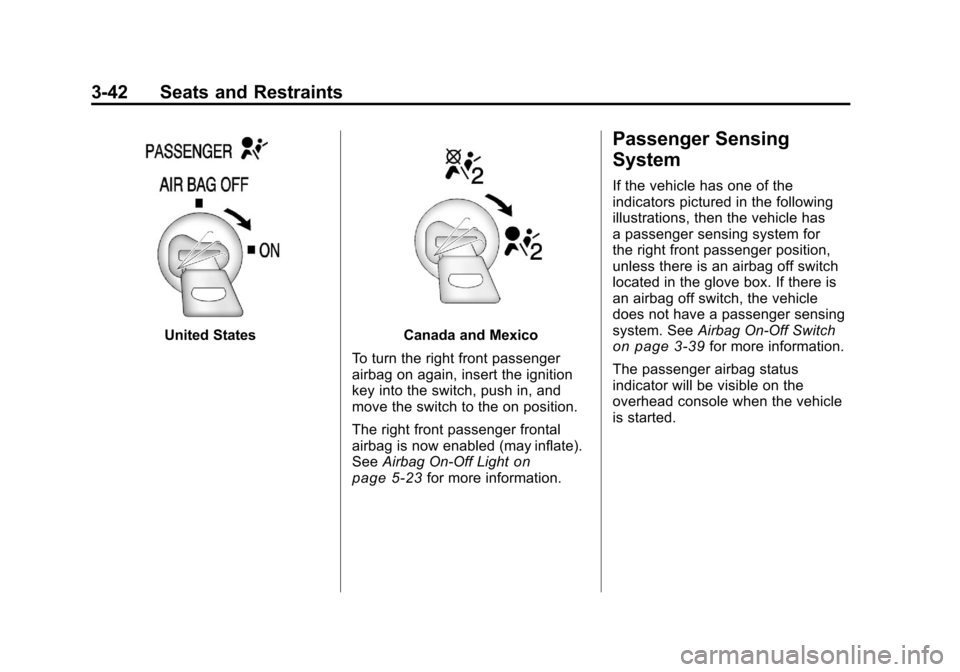
Black plate (42,1)Chevrolet Silverado Owner Manual - 2011
3-42 Seats and Restraints
United StatesCanada and Mexico
To turn the right front passenger
airbag on again, insert the ignition
key into the switch, push in, and
move the switch to the on position.
The right front passenger frontal
airbag is now enabled (may inflate).
See Airbag On-Off Light
on
page 5‑23for more information.
Passenger Sensing
System
If the vehicle has one of the
indicators pictured in the following
illustrations, then the vehicle has
a passenger sensing system for
the right front passenger position,
unless there is an airbag off switch
located in the glove box. If there is
an airbag off switch, the vehicle
does not have a passenger sensing
system. See Airbag On-Off Switch
on page 3‑39for more information.
The passenger airbag status
indicator will be visible on the
overhead console when the vehicle
is started.